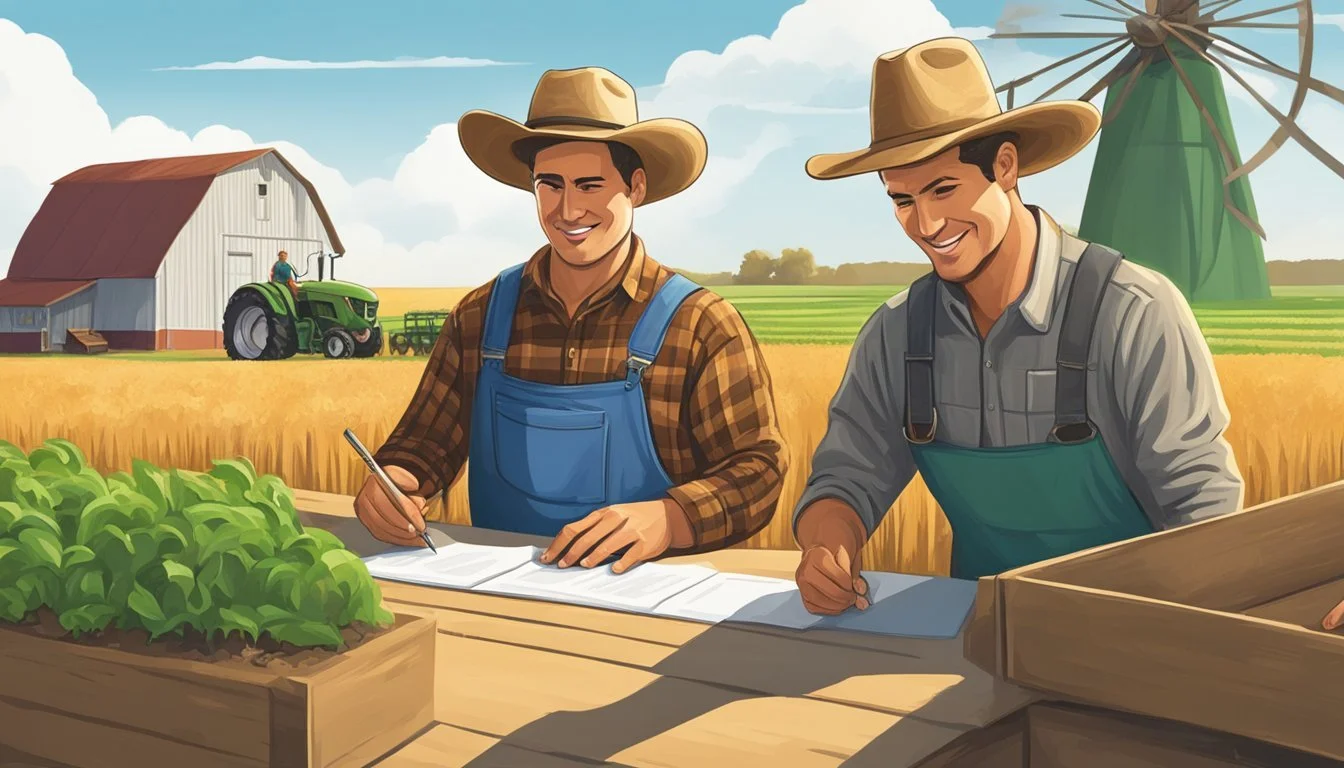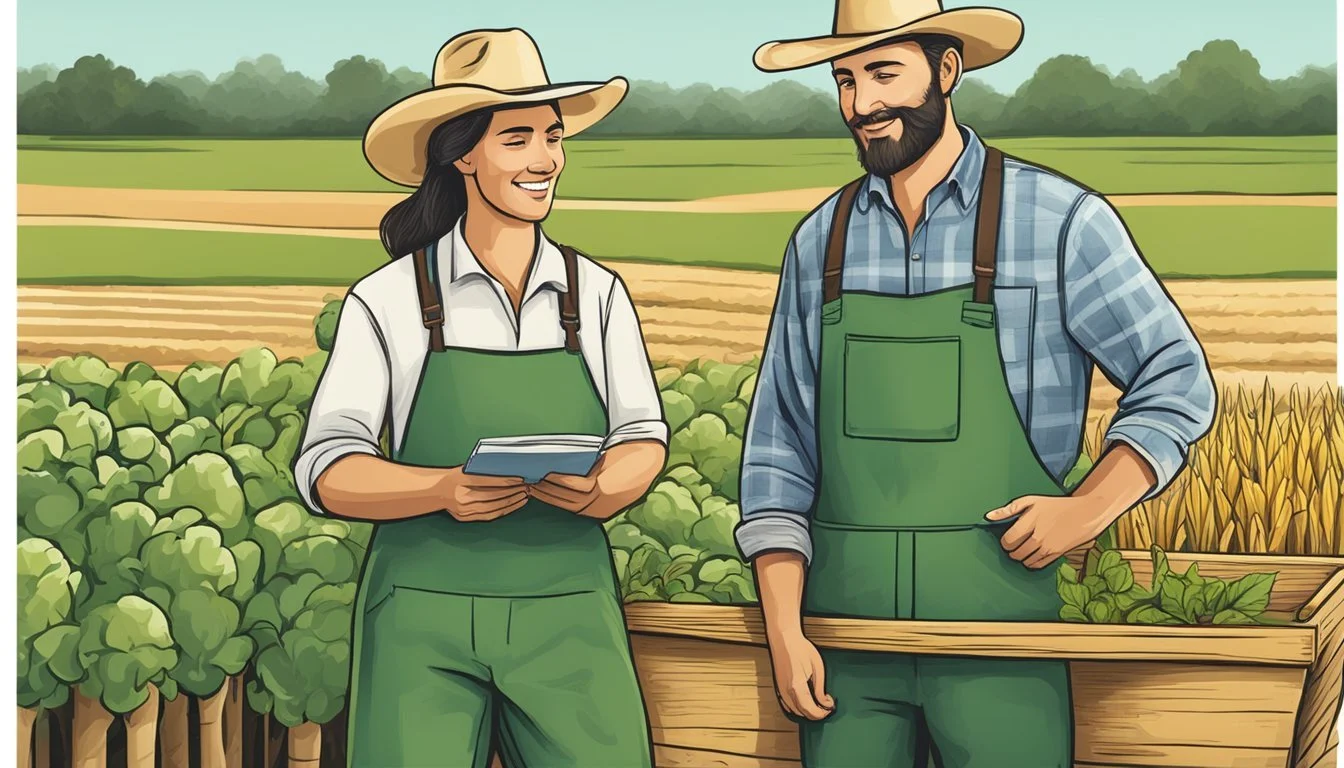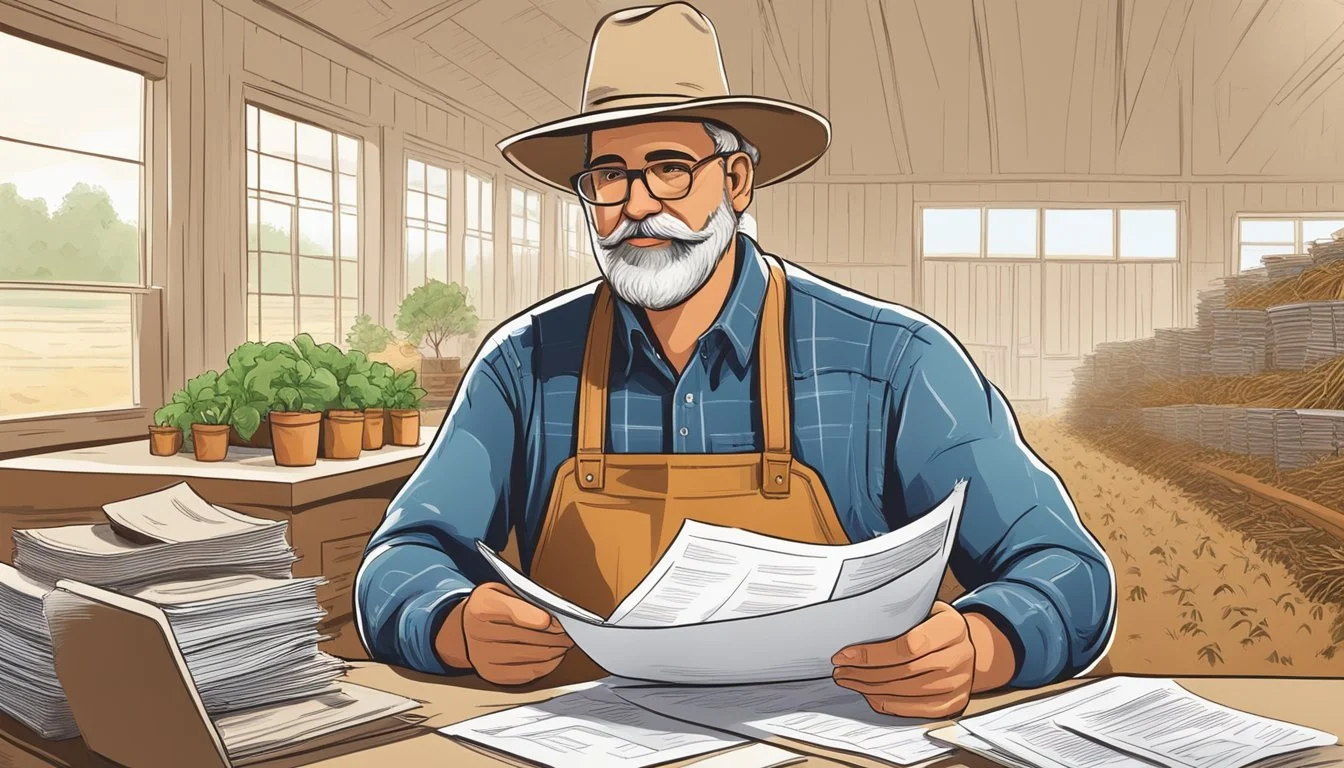Farm Loans in Texas
Navigating Financial Solutions for Agriculture
This Article is Part of Our Guide on Farm Loans for All 50 U.S. States
Farm loans in Texas provide crucial financial support to the state's agricultural community, enabling farmers and ranchers to purchase land, livestock, equipment, and necessary supplies. These agricultural loans are designed not just for large-scale operations but also to encourage and sustain smaller, family-size farms. In a state where agriculture plays a pivotal role in the economy, access to financial resources is essential, especially considering the challenges posed by the changing climate, market volatility, and the need to implement advanced farming technologies.
Credit is a lifeline for Texas farmers, serving as a foundation for both establishing new agricultural ventures and expanding existing ones. A variety of lending institutions, including specialized agricultural credit organizations, offer tailored loan products that cater to the diverse needs within the farming sector. These loans often come with competitive interest rates and terms designed to match the unique cash flow patterns of agricultural businesses.
Texas farm loans are made accessible through multiple programs, both at the state and federal levels, including direct and guaranteed loans. With options like the Agricultural Loan Guarantee Program and loans facilitated by the Farm Service Agency, aspiring and seasoned farmers alike find support for their operations. These financial tools aim to ease the entry barrier for newcomers in farming and to strengthen the stability of established agribusinesses in Texas.
Understanding Farm Loans in Texas
In Texas, farm loans support producers by providing essential capital for various agricultural needs. These loans facilitate everything from daily operations to long-term investments in land and equipment.
Types of Farm Loans
Operating Loans (OL): Designed to cover the costs of running a farm such as seeds, fertilizer, and living expenses.
Farm Ownership Loans (FO): Offered to producers to purchase farmland, construct buildings, or make farm improvements.
Youth Loans: Aimed at young individuals to finance agricultural projects.
Land Loans: Targeted at financing the purchase of agricultural land.
Equipment and Livestock Loans: Available for financing the purchase of machinery, livestock, and other necessary farm equipment.
Purpose and Benefits of Farm Loans
Farm loans serve to sustain and improve agricultural operations, allowing producers to:
Purchase necessary inputs like feed and seeds.
Invest in conservation and expansion projects.
Take advantage of opportunities such as dairy or crops diversification.
The benefits of these loans are substantial, offering flexible repayment terms and competitive interest rates, contributing to the growth and sustainability of the agricultural sector in Texas.
Key Entities Involved
Texas Farm Credit: A key lender providing various loan options tailored to ranchers and farmers' needs.
Farm Service Agency (FSA): Offers direct and guaranteed loans to family-size farmers and ranchers.
United States Department of Agriculture (USDA): Sets broader policies, including requirements such as minimum credit scores and income limits for certain loan programs.
Agriculture Lenders like AgTexas: Offer ag lending solutions including farm loans, insurance, and real estate financing.
These institutions ensure that agricultural producers have access to necessary financial resources, with programs designed to accommodate a range of agricultural and rural lending needs.
Loan Application Process
The loan application process for farmers and ranchers in Texas is a structured set of steps designed to secure credit for agricultural needs. The process is defined by clear eligibility criteria, essential documentation requirements, and sequential steps to ensure a smooth application experience.
Eligibility Criteria
To apply for a farm loan, an applicant must meet specific eligibility criteria set by the lending institution. For example, Texas Farm Credit requires:
That the borrower be involved in farming, ranching, or other agricultural production.
A viable business plan demonstrating the potential for success and repayment ability.
An assessment of operating expenses and projected income.
Eligibility may vary, so applicants should review the specific requirements of the lender or resource center.
Steps to Apply for a Loan
Applicants need to follow these steps when applying for a loan:
Review Eligibility Requirements: Confirm qualifications for the loan.
Develop a Farm Business Plan: Outline goals and how the loan will be used.
Contact the Lender: Reach out to Texas Farm Credit or the chosen lender's staff to discuss the loan.
Complete Application Forms: Fill in the necessary paperwork with accurate information.
Submit All Required Documentation: Ensure all requested documents are provided.
Loan Processing: The lender will review the application and may request additional information.
Approval & Closing: If approved, the applicant will work with the lender on the closing process, including addressing closing costs and down payment.
Required Documentation
Critical for a successful application is the submission of accurate and comprehensive documents. These typically include:
Proof of Identity: A valid government-issued photo ID.
Credit History: Credit reports to verify credit status.
Insurance: Evidence of adequate insurance for the assets involved.
Financial Statements: Documentation showcasing the applicant's financial position, including income, expenses, and existing debt.
Business Plan: A clear and detailed plan for the use of the loan.
Farmers and ranchers should prepare these documents prior to applying to streamline the process.
Loan Types and Terms
In Texas, farmers have access to a variety of loan types and terms designed to cater to the diverse needs of agricultural operations, ranging from financing equipment purchases to covering operating expenses.
Direct vs Guaranteed Loans
Direct Loans are offered by the Farm Service Agency (FSA) and provide capital to farmers directly from the federal government. Farmers might use these loans for a multitude of purposes, including operating expenses and refinancing debt. Guaranteed Loans, conversely, are made by lending institutions but backed by the FSA, which reduces the risk for lenders and can result in more favorable terms for borrowers. This assurance by the FSA facilitates farmers in acquiring loans that might otherwise be out of reach due to stringent credit requirements or other financial barriers.
Loan Repayment Terms
The repayment terms of a farm loan are critical for both lenders and borrowers. These terms vary based on loan type. Operating loans generally have shorter repayment periods as they are used for day-to-day expenses, while loans for purchasing real estate come with longer repayment terms, reflecting the substantial investment and lifecycle of the assets. Flexible loan programs may offer terms that align with the farming operation's cash flow, thereby assisting farmers in managing their finances more effectively.
Interest Rates and Fees
Interest rates for farm loans in Texas can be either fixed or variable, depending on the lender and the type of loan. Texas Farm Credit and other financial institutions offering agricultural loans usually outline their rates explicitly, which are influenced by market conditions and the creditworthiness of the borrower. Additional fees might include closing costs or fees for late payments. It's essential for prospective borrowers to thoroughly understand the interest rates and associated fees to evaluate the total cost of the loan and to ensure that it fits with their financial planning.
Additional Financial Support
In Texas, farmers and ranchers benefit from a variety of programs designed to provide additional financial support. These initiatives focus on mitigating risks associated with agriculture, such as unpredictable weather or market conditions, and fostering the next generation of agricultural professionals through education and financial incentives.
Insurance Programs
Farmers in Texas can access crop insurance and other insurance products to protect their operations from the inherent risks of farming. These programs offer coverage for losses to crops and livestock due to adverse weather conditions, price fluctuations, and other unforeseen challenges. Insurance serves as a critical safety net, ensuring that producers can recover and maintain economic stability.
Youth and Beginning Farmers Programs
Organizations like 4-H clubs and the Future Farmers of America (FFA) provide mentorship and support to young individuals and beginning farmers. The support includes:
Youth loans: to help finance agricultural projects for 4-H and FFA members.
New equipment: financial aid for purchasing essential machinery to start or expand operations.
Guidance on acquiring land loans for both farming and recreational property ventures.
These programs aim to empower the next generation with the necessary tools to sustainably enter and succeed in the world of agriculture.
Conservation and Environmental Programs
Texas offers programs focused on conservation and environmental sustainability, encouraging producers to implement practices that protect the land and natural resources. Assistance includes:
Financial support for implementing water conservation methods.
Initiatives to preserve the quality of soil and ecosystems.
Funding for projects that aim to enhance the environmental health of farming operations.
These programs reflect a commitment to sustainable agriculture, ensuring that the land remains productive and viable for future generations.
Strategies for Financial Management
This section guides readers through optimizing their financing strategies, focusing on the apt utilization of farm loans, effective risk management, and planning for sustainable growth through expansion and diversification.
Effective Use of Loans
Understanding the proper use of loans is pivotal for financial stability. Farmers should prioritize operating loans to cover immediate needs like seed, livestock, and equipment. It's crucial to allocate loans to generate income, ensuring expenses such as feed, fertilizer, and fuel are managed efficiently. Strategic investment in new equipment can enhance productivity, translating to more competitive operations.
Operating Loans: Allocated for assets that directly impact day-to-day farming operations.
Equipment Loans: Used for purchasing tractors, harvesters, and other essential machinery.
Loans should not just cover costs but also fuel growth. Investing in livestock or crops can lead to increased production, offering a better financial footing.
Risk Management
Farmers must proactively manage risks with tools like crop insurance and livestock insurance to safeguard against unforeseeable losses due to extreme weather or market fluctuations. A comprehensive insurance strategy allows farmers to stabilize their income and ensure continuity of operations.
Crop Insurance: Protects against the loss of crops due to natural disasters or the drop in the value of agricultural commodities.
Livestock Insurance: Provides coverage against unexpected livestock losses.
Through proper risk management, farmers can maintain solvency and invest confidently in their farming operations.
Planning for Expansion and Diversification
In planning for expansion, farmers should evaluate the potential of adding recreational property or diversifying into different crop varieties to broaden revenue streams. Tactical thinking in conservation efforts can also lead to long-term cost savings and compliance with regulatory standards. Diversifying operations not only mitigates risks but can also capitalize on new market opportunities.
Expansion: Could include acquiring more land for crop production or livestock farming.
Diversification: Involves cultivating different types of crops or branching out into agritourism.
Strategic planning helps ensure that any expansion or diversification meets the farm's goals and resource capabilities while fostering sustainable growth.
Farmer Resources and Assistance
Farmers and ranchers in Texas have access to a variety of resources designed to promote agricultural success and sustainability. From educational programs to financial assistance, various entities work together to ensure that those in the agricultural sector are well-supported.
Education and Information
Resource Centers such as Texas A&M AgriLife Extension serve as hubs for education and information, providing services to farmers and ranchers. They offer resources that cover a wide range of topics, including crop production, farm management, and conservation techniques.
Agricultural Lending Institutions, like Texas Farm Credit and AgTexas, offer tailored Ag Loans to support the farming community. These institutions provide access to capital through various loan products, including Farm Ownership Loans and Farm Operating Loans.
Agricultural Community Support
Local County Extensions are pivotal in supporting the regional agricultural community by offering resources and organizing programs like 4-H and Future Farmers of America (FFA), which focus on the development of the next generation of farmers and agricultural professionals.
Agribusiness Loans are provided by entities like the USDA Farm Service Agency (FSA), which helps producers through direct and guaranteed loans, enabling them to purchase land, equipment, and supplies, as well as make farm improvements.
Legislation and Advocacy
Farm Service Agency (FSA) and USDA programs reflect the latest in agricultural legislation and policy, advocating for farmers' and ranchers' needs at both the state and federal level. They offer platforms for producers to voice their concerns and help shape the agricultural landscape in Texas.
Producers can benefit from the Agricultural Loan Guarantee Program by the state, which assists in establishing or enhancing farming or ranching operations, or to establish an agricultural-related business, guaranteeing a portion of the loan taken by farmers and ranchers.





